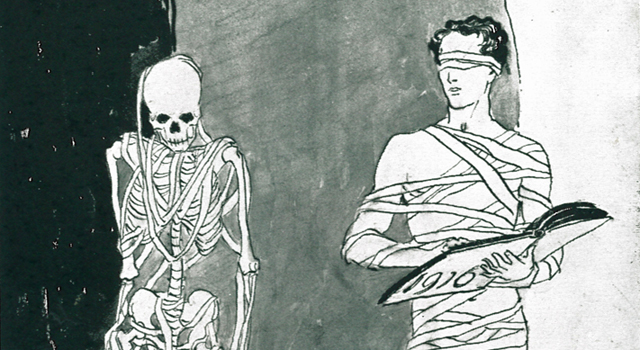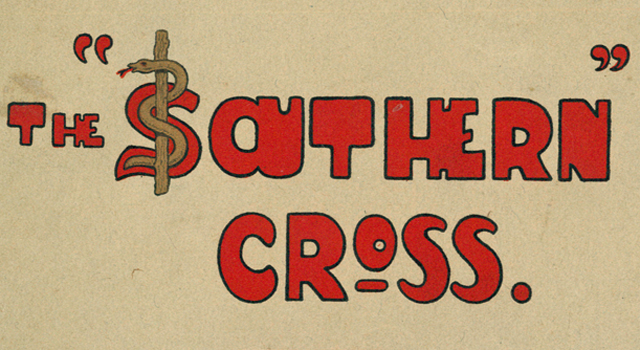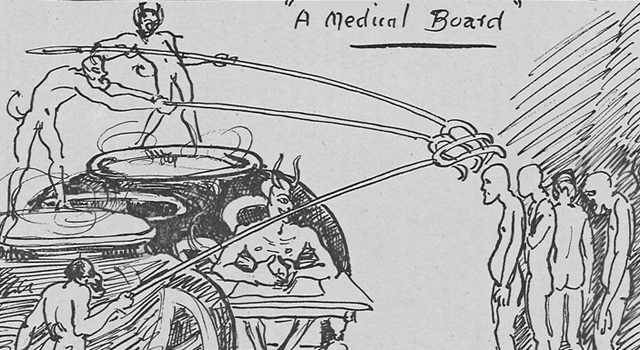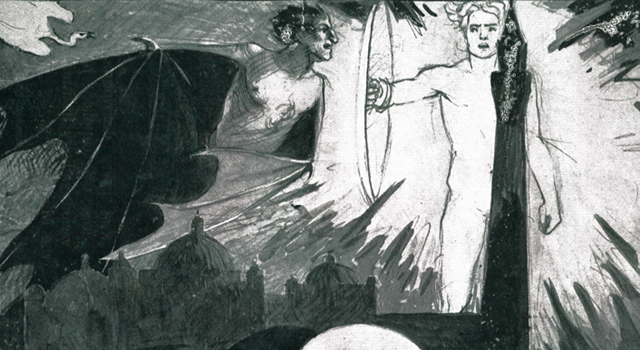Articles
No Comments
By Voices
On 06, Mar 2014 | No Comments | In Commemoration | By Voices
Images of War by W.L. Sherwood
Martin Killeen, Cadbury Research Library, University of Birmingham
www.suburbanbirmingham.org.uk
Preceded only by the cover of The Southern Cross magazine, 1915/1916 is a composition by W.L. Sherwood, a Staff Sergeant at Edgbaston’s military hospital. Before the reader of this journal encounters the calm reassurance of the established conventions (portrait photography and prose), with 1915/1916 Sherwood has introduced a disquieting sense of ambiguity to produce a complex response to his themes of war, suffering, survival and death and to their Edgbaston campus setting.
![1915/1916 by W.L. Sherwood 1915/1916 by W.L. Sherwood [University of Birmingham Special Collections: rR31.S9]](http://www.voicesofwarandpeace.org/wp-content/uploads/2014/03/1915-1916-crl-rR31-S9.jpg) 1915/1916 offers a quite different message from the rest of the magazine content, such as the official photograph of the dignified Lt-Colonel Marsh in his uniform and the clear and forthright opening statement of his Foreword:
1915/1916 offers a quite different message from the rest of the magazine content, such as the official photograph of the dignified Lt-Colonel Marsh in his uniform and the clear and forthright opening statement of his Foreword:
the restoration of the sick and wounded to health means the return of trained soldiers, experienced in the arts of war and the wiles of the enemy, to the firing line.
1915/1916 is starkly challenging in its presentation of two figures standing on a globe under an enormous dark winter sun against a background clearly inspired by the Edgbaston campus buildings and overshadowed by a towering structure (possibly the Chamberlain Clock Tower). The skeleton of a wounded soldier (as indicated by his draping bandages) is 1915, the year just finished, representing all the recent dead, the record of their demise in the book lying face down on the ground. The living figure meanwhile offers only a qualified sense of hope; he looks whole and well and there is elegance and beauty in his pose, but he also has draping bandages, so he is one of the wounded as well; in his hands he holds the book of the future (‘1916’), which he cannot see as he is blindfolded – there is no end in sight and he might expect to be in the place of the skeleton at the end of the year. The work expresses a mixture of feelings: loss and uncertainty in a world precariously balanced between hope and fear, life and death.
![Issue 1 of The Southern Cross [University of Birmingham Special Collections: rR31-S9]](http://www.voicesofwarandpeace.org/wp-content/uploads/2014/03/southern-cross-1-crl-rR31-S9.jpg) The Southern Cross mainly comprised institutional news, reviews of entertainment and sporting events, announcements and a variety of prose, verse and graphics often including humorous depictions of staff and comical representations of ward life. This provided a sense of collective significance for all those involved, that their ordeal would not be forgotten and that the magazine ‘will be found worthy of retention for reference in years to come’.
The Southern Cross mainly comprised institutional news, reviews of entertainment and sporting events, announcements and a variety of prose, verse and graphics often including humorous depictions of staff and comical representations of ward life. This provided a sense of collective significance for all those involved, that their ordeal would not be forgotten and that the magazine ‘will be found worthy of retention for reference in years to come’.
Although it was authorised and subject to censorship, the journal met a recognised need to have a safety valve for the feelings of the recovering soldiers. It gave them an opportunity to find relief from wartime pressures by giving vent to complaints, criticism, disillusion and frustrations, albeit within a context supervised by the hospital management.
![A Medical Board by W.L. Sherwood, 1917 [University of Birmingham Special Collections: rR31.S9]](http://www.voicesofwarandpeace.org/wp-content/uploads/2014/03/southern-cross-2-medical-board.jpg) This caricature by Sherwood presents a sardonic view of the Medical Boards, which decided the fates of many soldiers during the First World War. Consisting of a panel of both military and civilian doctors, the boards sat to assess the individual fitness for work, service or pension (a disability allowance) of those who had been wounded or invalided in any way. The view from across the table, however, was evidently quite different. In A Medical Board Sherwood depicts the President of the Board as Satan being aided by devils. The process is portrayed as both capricious and malicious, with the men appearing as lost naked defenceless souls; helpless to resist and begging for mercy, they are ruthlessly raked to their doom in one of three cauldrons A, B or C. The target of the satire here is partly the insatiable habit of the military machine to consign individuals to their destiny by grading them, irrespective of their wishes and without their co-operation.
This caricature by Sherwood presents a sardonic view of the Medical Boards, which decided the fates of many soldiers during the First World War. Consisting of a panel of both military and civilian doctors, the boards sat to assess the individual fitness for work, service or pension (a disability allowance) of those who had been wounded or invalided in any way. The view from across the table, however, was evidently quite different. In A Medical Board Sherwood depicts the President of the Board as Satan being aided by devils. The process is portrayed as both capricious and malicious, with the men appearing as lost naked defenceless souls; helpless to resist and begging for mercy, they are ruthlessly raked to their doom in one of three cauldrons A, B or C. The target of the satire here is partly the insatiable habit of the military machine to consign individuals to their destiny by grading them, irrespective of their wishes and without their co-operation.
![War by W.L. Sherwood [University of Birmingham Special Collections: rR31.S9]](http://www.voicesofwarandpeace.org/wp-content/uploads/2014/03/war-crl-rr3.jpg) Whilst Sherwood also submitted humorous caricatures to the journal and he later concentrated on a set of atmospheric views of the military hospital buildings, Sherwood produced his most potent art when the subject was presented through this visionary and symbolic style, which he went on to use in a series of companion frontispieces published in the early issues of The Southern Cross.
Whilst Sherwood also submitted humorous caricatures to the journal and he later concentrated on a set of atmospheric views of the military hospital buildings, Sherwood produced his most potent art when the subject was presented through this visionary and symbolic style, which he went on to use in a series of companion frontispieces published in the early issues of The Southern Cross.
This dramatic frontispiece to the fourth issue in 1916 is entitled simply War. The picture balances opposite motifs of light and dark to represent good and evil against the background of the Edgbaston military hospital; if you imagine the buildings only then the picture would join the other more realistic views of the University drawn by Sherwood, which appear in other issues of the journal. Here however, the scene is symbolic and apocalyptic with the buildings not standing on level ground but on the curve of the globe, so that the picture addresses the fate of the whole world in crisis.
The Southern Cross, monthly journal of the 1st Southern General Hospital, Birmingham, was edited by N. Pollock, and ran from January 1916 to Vol. 3 No. 32 in 1919.
This is an extract from www.suburbanbirmingham.org.uk







Submit a Comment